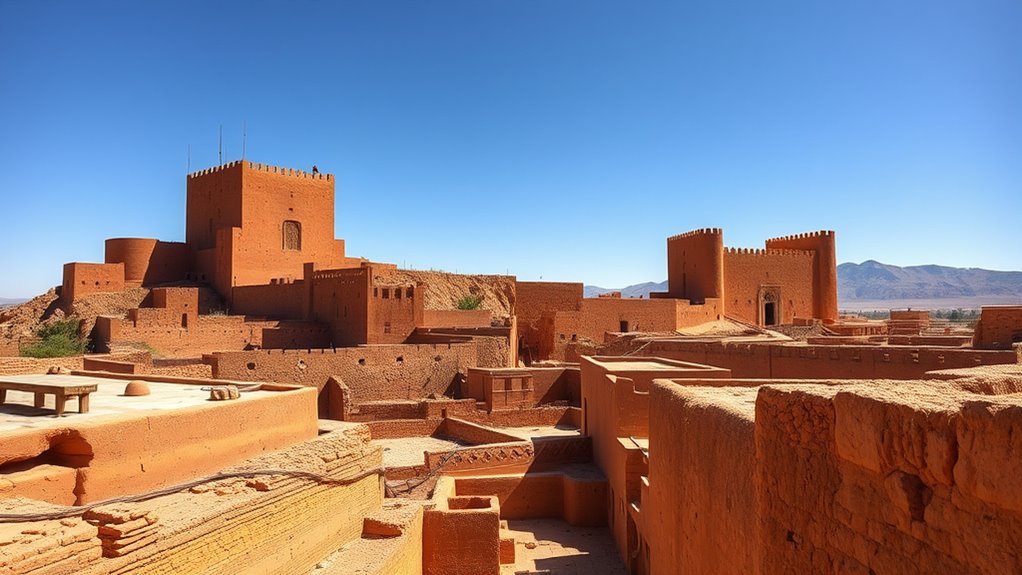Explore Morocco’s top attractions, starting with Marrakech’s lively Jemaa el-Fnaa square and serene Jardin Majorelle. Visit the UNESCO-listed Aït Ben Haddou for its stunning mud-brick architecture and cinematic fame. Relax on the Atlantic coast at Taghazout Bay, known for surfing and vibrant beaches. Wander the historic streets of Fez’s ancient medina and experience its markets and tanneries. Discover Chefchaouen’s blue-painted streets and nearby natural beauty. Keep going to uncover even more Moroccan wonders.
Key Takeaways
- Jemaa el-Fnaa square in Marrakech, bustling with storytellers, performers, and food stalls, especially at sunset.
- Aït Ben Haddou, a UNESCO World Heritage site with iconic mud-brick architecture featured in famous films.
- Coastal surf spots in Taghazout Bay, offering powerful waves, seaside cafés, and sunset yoga sessions.
- The historic medina of Fez, with maze-like streets, vibrant souks, and traditional tanneries.
- Blue-painted streets of Chefchaouen nestled in the Rif Mountains, surrounded by natural waterfalls and hiking trails.
Marrakech: The Cultural and Historical Heart

Marrakech stands out as Morocco’s vibrant cultural and historical heart, where ancient traditions blend seamlessly with lively modern energy. You’ll find yourself immersed in the bustling Jemaa el-Fnaa square, alive with storytellers, musicians, and food stalls, especially at sunset. The Jardin Majorelle offers a splash of color, with exotic plants and striking blue walls that beckon you to relax. As you explore, the Koutoubia Mosque’s towering minaret guides your way, a symbol of Marrakech’s spiritual heritage. The opulent Bahia Palace showcases stunning Moroccan architecture and lush gardens, perfect for wandering. Meanwhile, the traditional souks tempt you with spices, textiles, and crafts, especially early in the morning when the streets are quieter. This city’s vibrant blend of history and culture creates an unforgettable experience. Notably, Marrakech’s cultural significance is reflected in its diverse attractions and traditions that have been preserved over centuries.
Aït Ben Haddou: The Iconic Film Location and UNESCO Site

Perched on the edge of the Sahara, Aït Ben Haddou is a stunning example of traditional Moroccan desert architecture that has earned its place as a UNESCO World Heritage Site. As you explore, you’ll notice its impressive mud-brick structures, fortified walls, and winding alleyways that reflect centuries of desert life. This ancient ksar served as a crucial trading post along the route to the Sahara, preserving its historic charm. You might recognize it from famous films like *Gladiator* and *Game of Thrones*, making it a must-visit filming location. To truly appreciate its beauty, visit at sunrise or sunset when the light casts dramatic shadows over the fortress. From the panoramic views to its authentic architecture, Aït Ben Haddou offers a mesmerizing glimpse into Morocco’s rich history. Hydroponics and aeroponics are innovative farming methods that enable cultivation in arid environments, similar to the desert setting of Aït Ben Haddou.
Coastal Adventures at Taghazout Bay

Taghazout Bay offers a perfect escape to Morocco’s Atlantic coast, where the rhythm of the waves and vibrant surf culture await. You’ll find some of the best beaches in the country, ideal for both beginners and experienced surfers. Anchor Point, in particular, draws international competitions with its powerful swells and consistent breaks. When you’re not riding waves, relax at seaside cafés or practice rooftop yoga as the warm sun sets over the ocean. The laid-back vibe makes it easy to unwind and soak up local life. Whether you’re catching waves, exploring hidden coves, or simply enjoying the fresh sea breeze, Taghazout Bay promises an authentic coastal adventure. It’s a spot that caters to surf lovers and beach seekers alike, offering unforgettable experiences by the Atlantic. The area is also known for its vetted accommodations and surf schools], ensuring a comfortable and enriching stay for all visitors.
Exploring the Ancient Medina of Fez

The ancient medina of Fez invites you to step into a living maze of narrow alleyways, historic mosques, and artisan workshops that have preserved centuries of Moroccan culture. As you navigate its labyrinthine streets, you’ll encounter vibrant souks filled with spices, textiles, and handcrafted goods. Don’t miss the medina’s renowned tanneries, where you can observe traditional leather-dyeing techniques firsthand. You’ll also find impressive landmarks like the Bou Inania Madrasa and the Karaouine Mosque, both exemplifying Islamic architecture and spiritual heritage. Guided tours help you uncover the medina’s rich history and vibrant daily life. Here, every turn reveals a new story, a crafting tradition, or a centuries-old building, immersing you in the authentic heart of Morocco’s cultural legacy. Open floor plans in traditional Moroccan architecture often feature interconnected spaces that promote social interaction and fluid movement throughout the medina.
The Charm of Chefchaouen and Natural Wonders

Nestled amidst Morocco’s Rif Mountains, Chefchaouen captivates visitors with its striking blue-washed streets and serene mountain views. As you explore, you’ll find the city’s peaceful atmosphere perfect for relaxing and photography. The narrow alleys and vibrant blue walls create a calming, almost magical ambiance. Just outside the town, Akchour offers rugged hiking trails, waterfalls, and natural rock formations like God’s Bridge, ideal for adventure seekers. In summer, you can enjoy swimming in river pools and soaking in the natural beauty. Camping here allows you to fully immerse yourself in the landscape, away from commercial hustle. Whether wandering through blue streets or hiking scenic trails, you’ll experience Morocco’s natural charm and tranquility in this enchanting mountain retreat. **In addition, the area is known for its natural beauty and diverse flora and fauna, making it a perfect spot for nature enthusiasts.**
Frequently Asked Questions
What Are the Best Times of Year to Visit Morocco’s Top Attractions?
You should visit Morocco’s top attractions in spring (March to May) or fall (September to November) when the weather is pleasant and comfortable. During these seasons, you can explore Marrakech’s vibrant souks, Aït Ben Haddou’s dramatic scenery, and Chefchaouen’s blue streets without extreme heat or cold. Avoid the intense summer heat and winter rains, ensuring a more enjoyable experience as you discover Morocco’s diverse landscapes and rich culture.
How Can Travelers Experience Local Moroccan Cuisine Authentically?
You can’t truly taste Morocco without diving headfirst into its vibrant food scene. Visit bustling markets early in the morning, where the aroma of spices and fresh ingredients feels like a warm hug. Dine at family-run restaurants, sharing tagines and pastillas with locals, and learn their recipes. Embrace street food stalls, where every bite tells a story, giving you an authentic, unforgettable flavor of Moroccan culture.
Are Guided Tours Necessary to Explore Morocco’s Historical Sites Effectively?
Guided tours are highly helpful for exploring Morocco’s historical sites effectively. They provide valuable insights into the sites’ history, architecture, and cultural significance, enriching your experience. With a guide, you’ll navigate complex layouts like medinas or ancient ruins more easily, avoid missing hidden details, and ask questions. Plus, tours often include transportation and skip-the-line access, making your visit smoother and more educational, especially if you’re unfamiliar with local history.
What Safety Tips Should Travelers Keep in Mind While Visiting Remote Areas?
When visiting remote areas in Morocco, you should prioritize safety by staying on marked paths, avoiding risky terrain, and carrying enough supplies. It’s wise to travel with a local guide familiar with the area, especially in unfamiliar or rugged spots. Keep your valuables secure, inform someone about your plans, and be mindful of weather conditions. Respect local customs and ask for advice to ensure a safe and enjoyable adventure.
How Accessible Are Morocco’s Natural Landscapes for Travelers With Mobility Challenges?
You’ll find Morocco’s natural landscapes quite welcoming, though some areas may require a bit of extra planning. While places like Chefchaouen and the coastal beaches offer smooth pathways and scenic ramps, others like the desert or mountain trails might challenge mobility. With proper arrangements, such as guided tours or accessible transport, you can enjoy the breathtaking views and natural beauty Morocco offers, making your adventure both memorable and comfortable.
Conclusion
As you explore Morocco’s vibrant cities and stunning landscapes, you’ll quickly see this country is a treasure trove waiting to be uncovered. From bustling markets to serene beaches, each destination offers a new story to tell. Embrace the adventure and immerse yourself fully—you never know what hidden gems you might stumble upon. Remember, Morocco’s beauty is a diamond in the rough, shining brightest when you venture off the beaten path.










